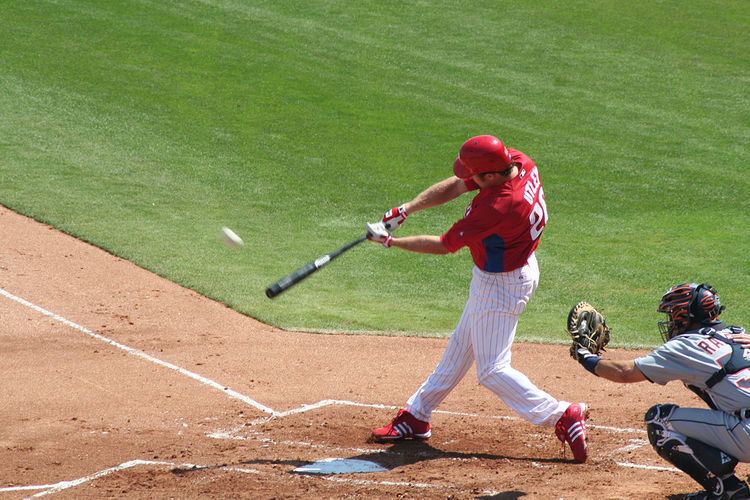 | ||
In baseball, hitting mechanics studies the biomechanical motion that governs the swing of a baseball player. The goal of biomechanics in hitting during baseball training is to study and improve upon the physics involved in hitting. This includes optimizing a player’s swing for either maximizing their "bat speed" or time for plate coverage. There is a wide range of batting stances and mechanics that are developed through individual preferences. However, when comparing among experienced baseball players, their batting mechanics approach are almost similar.
Contents
Hitting analysis
Hitters have a wide variation of swings, but in the end staying balanced and having stable posture is the most important aspect of hitting a baseball. If the hitter becomes unbalanced throughout the swing the chance of making solid contact with the baseball is very slim. Once balanced throughout the swing, bat speed comes into the next most important aspect of the baseball swing. The faster the bat speed, the faster the ball will come off the bat. Furthermore, researchers have long established that bat speed and home run hits are critically dependent of one another. Most notably, one can logically assume that a faster swing will result in the ball traveling farther. A 3-6% increase in bat speed can significantly affect the distance a ball travels after contact in competition (7). In terms of simple physics and mathematics, the conservation of momentum (E1) and a kinematic equation (E2) also reinforces this idea.
A study used an intensive mathematical program (finite element analysis software) to confirm that ball exit velocity is indeed dependent on linear bat velocity. These findings and observations confirm that a faster swing will be beneficial to a baseball player. In a research done by Welsh and et al. for the Journal of Orthopaedic and Sport Physical Therapy, they found that every baseball player goes through three critical phases during their swing. The three phases are foot off, foot down, and ball contact. In addition, they found that maximum hip rotation (around 714 degrees per second) happens right after foot down and maximum bat velocity (around 31 meters per second) before ball contact. These are significant markers since the hips generate the power needed for the bat speed which determines the distance the ball travels. Most biomechanics research hypothesis involving baseball takes those parameters as key values that can determine the success of a hitter. Furthermore, a hitter’s mechanics will also includes an initial short “windup” motion and a final follow through phase that completes the motion.
Biomechanic description of hitting
From the anatomic position, a common baseball player batting from the right side will exhibit these movements before the pitch. The hitter will start with both knees, ankles, and elbows in flexion and adducted. In addition, the shoulder will be slightly elevated, hand medially rotated, right arm abducted, left arm adducted, fingers full flexed around the bat, and neck externally rotated towards the pitcher. During the pitcher's windup, the hitter will continue to flex his/her left knee and extend their left ankle off the ground while rotating their hips away from the pitcher. After the pitch is thrown, the hitter will then fully extend their elbows, left knee, and left ankle while rotating their hips towards the pitcher. After perceived ball contact, the hips continue to rotate along with continue extension towards hyperextension of the elbow.
